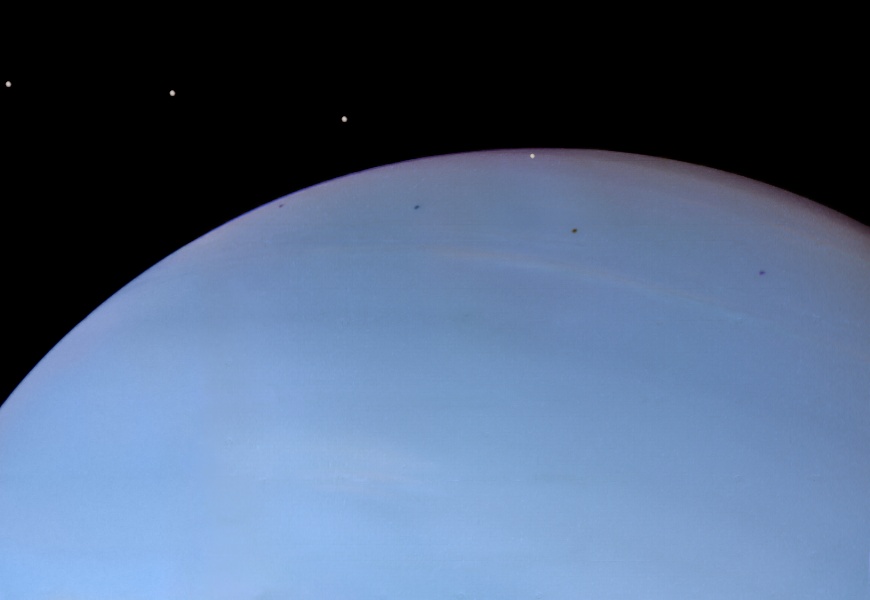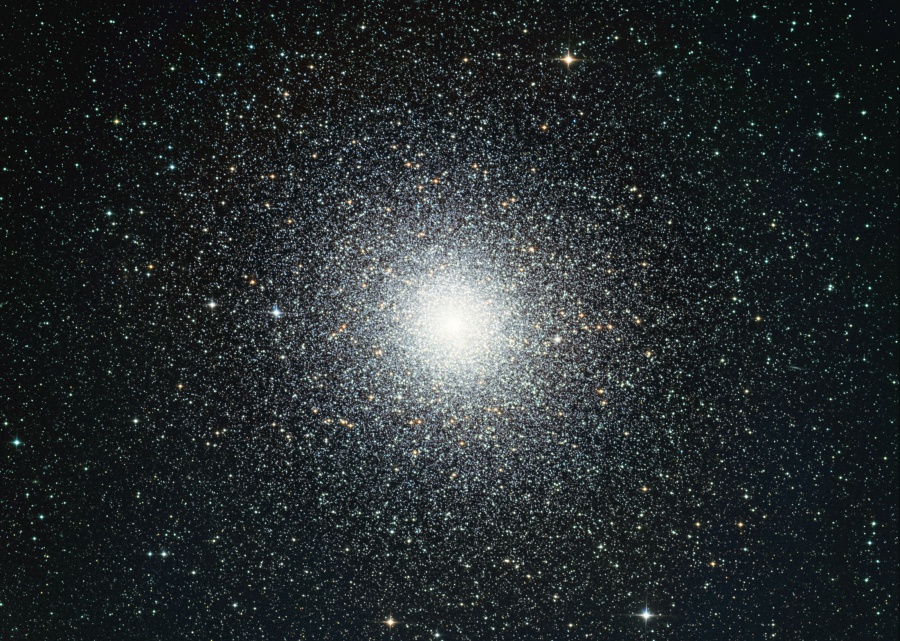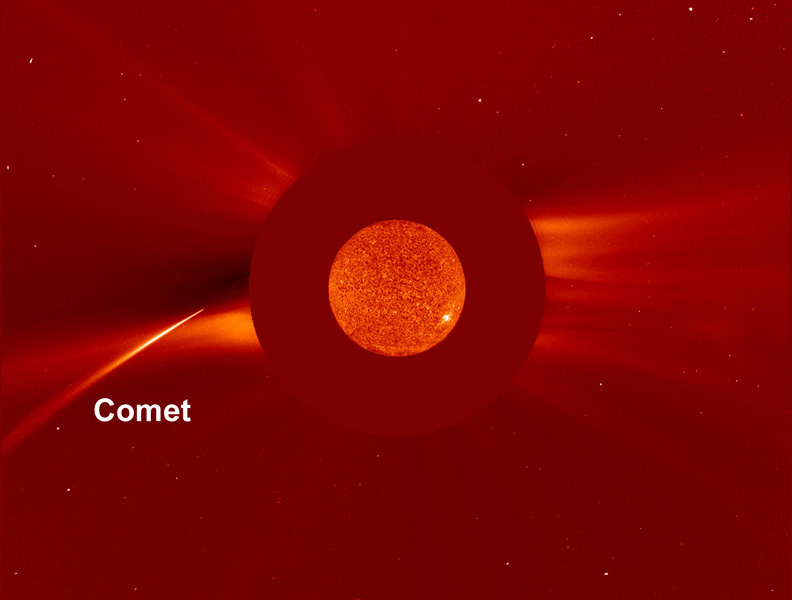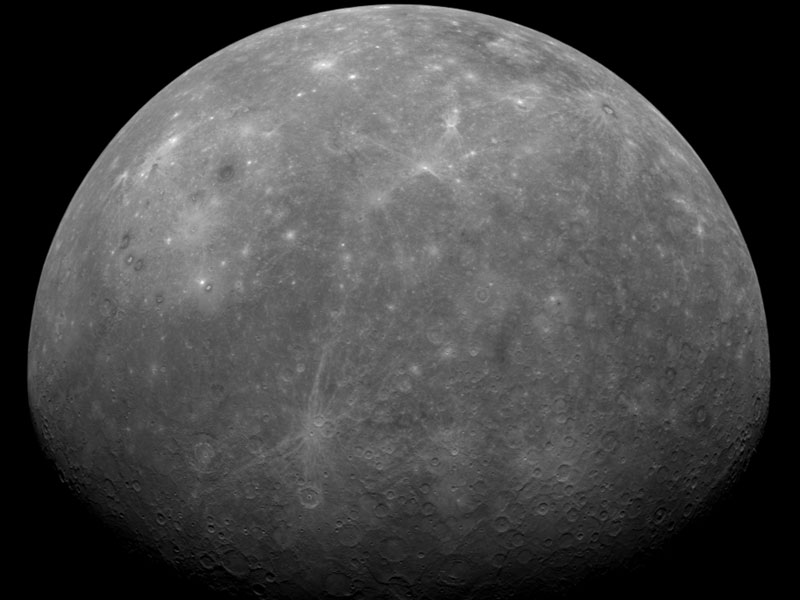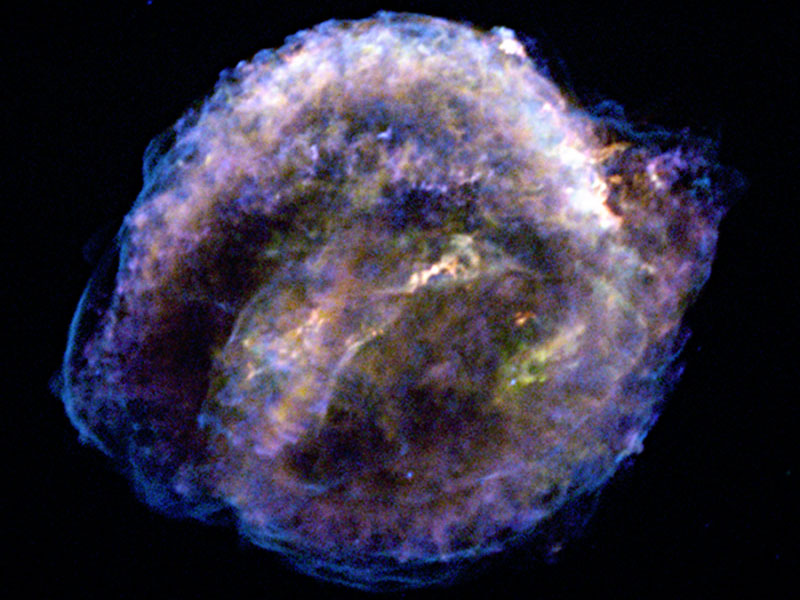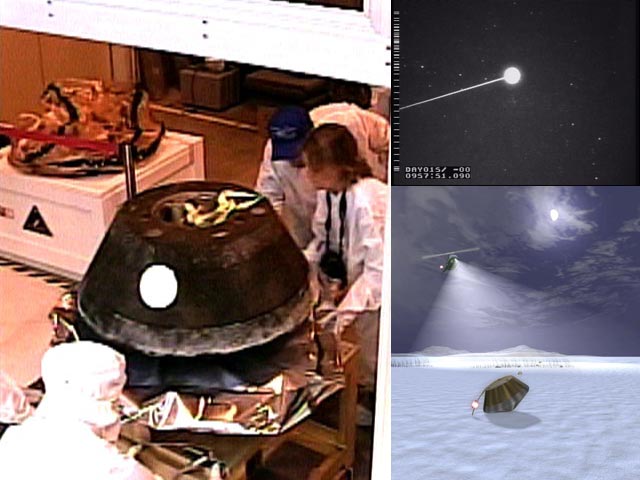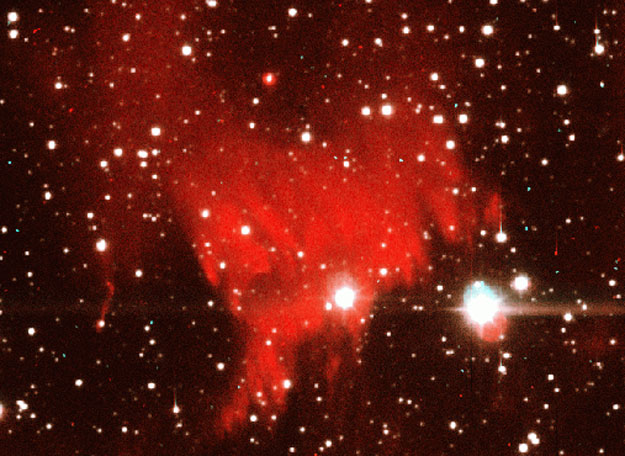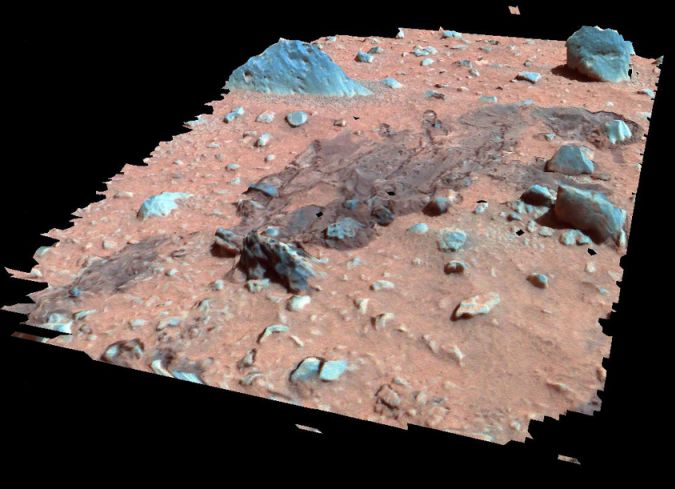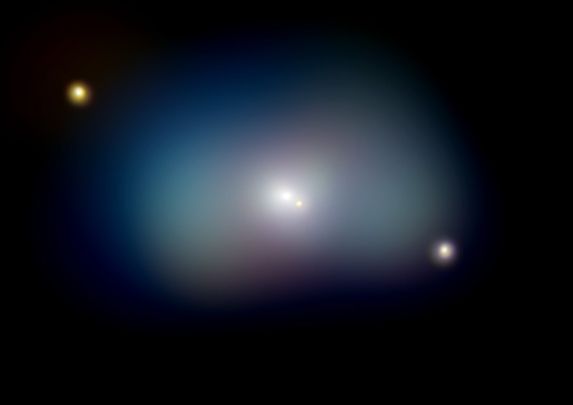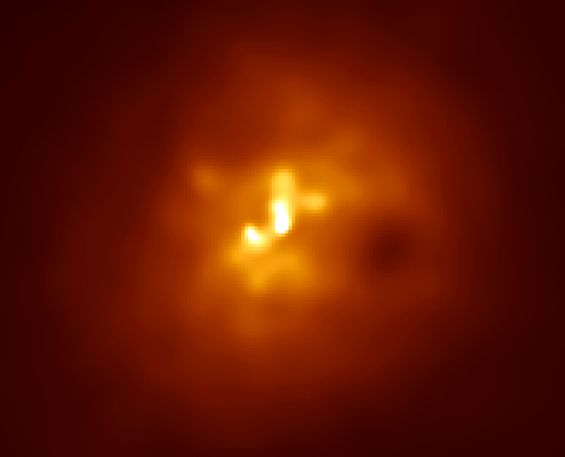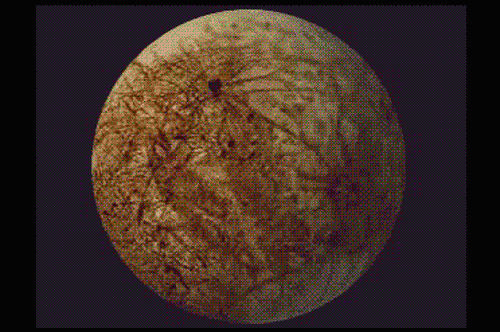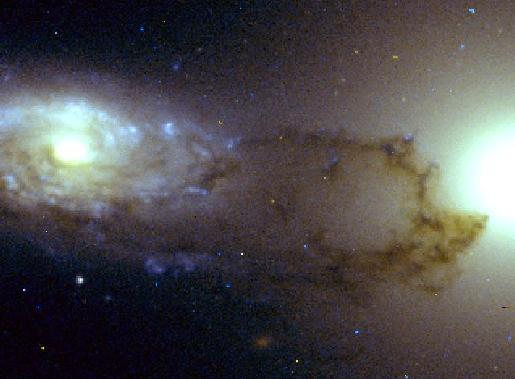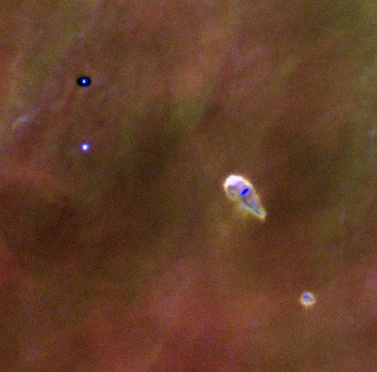| << Previous | Index | Next >> |
2015 Delivered by Saturn-bound Cassini, ESA's Huygens probe touched down on the ringed planet's largest moon Titan, ten years ago on January 14, 2005. These panels show fisheye images made during its slow descent by parachute through Titan's dense atmosphere. Taken by the probe's descent imager/spectral radiometer instrument they range in altitude from 6 kilometers (upper left) to 0.2 kilometers (lower right) above the moon's surprisingly Earth-like surface of dark channels, floodplains, and bright ridges. But at temperatures near -290 degrees F (-180 degrees C), the liquids flowing across Titan's surface are methane and ethane, hydrocarbons rather than water. After making the most distant landing for a spacecraft from Earth, Huygens transmitted data for more than an hour. The Huygens data and a decade of exploration by Cassini have shown Titan to be a tantalizing world hosting a complex chemistry of organic compounds, dynamic landforms, lakes, seas, and a possible subsurface ocean of liquid water.
2014 Despina is a tiny moon of Neptune. A mere 148 kilometers across, diminutive Despina was discovered in 1989, in images from the Voyager 2 spacecraft taken during its encounter with the solar system's most distant gas giant planet. But looking through the Voyager 2 data 20 years later, amateur image processor and philosophy professor Ted Stryk discovered something no one had recognized before -- images that show the shadow of Despina in transit across Neptune's blue cloud tops. His composite view of Despina and its shadow is composed of four archival frames taken on August 24, 1989, separated by nine minutes. Despina itself has been artificially brightened to make it easier to see. In ancient Greek mythology, Despina is a daughter of Poseidon, the Roman god Neptune.
2013 A gorgeous spiral galaxy some 100 million light-years distant, NGC 1309 lies on the banks of the constellation of the River (Eridanus). NGC 1309 spans about 30,000 light-years, making it about one third the size of our larger Milky Way galaxy. Bluish clusters of young stars and dust lanes are seen to trace out NGC 1309's spiral arms as they wind around an older yellowish star population at its core. Not just another pretty face-on spiral galaxy, observations of NGC 1309's recent supernova and Cepheid variable stars contribute to the calibration of the expansion of the Universe. Still, after you get over this beautiful galaxy's grand design, check out the array of more distant background galaxies also recorded in this sharp, reprocessed, Hubble Space Telescope view.
2012
Click to play embedded YouTube video.
Image Credit & Copyright: Nilesh Vayada & Ajay Talwar (TWAN)
2011 Globular star cluster 47 Tucanae is a jewel of the southern sky. Also known as NGC 104, it roams the halo of our Milky Way Galaxy along with some 200 other globular star clusters. The second brightest globular cluster (after Omega Centauri) as seen from planet Earth, it lies about 13,000 light-years away and can be spotted naked-eye near the Small Magellanic Cloud in the constellation of the Toucan. The dense cluster is made up of several million stars in a volume only about 120 light-years across. Red giant stars on the outskirts of the cluster are easy to pick out as yellowish stars in this sharp telescopic portrait. Globular cluster 47 Tuc is also home to exotic x-ray binary star systems.
2010 Intense and overwhelming, the direct glare of the Sun is blocked by the smooth occulting disk in this image from the sun-staring SOHO spacecraft. Taken on January 3rd, an extreme ultraviolet image of the Sun to scale, is superimposed at the center of the disk. Beyond the disk's outer boundary is a sungrazer comet, one of the brightest yet seen by SOHO. The comet was discovered (movie link) by Australian amateur astronomer Alan Watson, while examining earlier images from another sun-watching spacecraft, STEREO-A. Based on their orbits, sungrazers are believed to belong to the Kreutz family of comets, created by successive break ups from a single large parent comet that passed very near the Sun in the twelfth century. Subjected to strong tidal forces and intense solar heat, this sungrazer comet did not survive its close encounter.
2009
[imghover6=http://apod.nasa.gov/apod/image/0901/IS ... 74532t.jpg]http://apod.nasa.gov/apod/image/0901/IS ... beled1.jpg[/imghover6]Credit & Copyright: Ralf Vandebergh
2008 Two days ago, the MESSENGER spacecraft became only the second spacecraft in human history to swoop past Mercury. The last spacecraft to visit the Sun's closest planet was Mariner 10 over 35 years ago. Mariner 10 was not able to photograph Mercury's entire surface, and the images it did send back raised many questions. Therefore, much about planet Mercury remains unknown. This week's flyby of MESSENGER was only the first of three flybys. Over the next few years MESSENGER will swing past twice more and finally enter Mercury's orbit in 2011. MESSENGER is currently moving too fast to enter orbit around Mercury now. The above image was taken two days ago during MESSENGER's flyby and shows part of Mercury's surface that has never been imaged in detail before. Many more detailed images of Mercury are expected to be sent back over the next few days. The data acquired by MESSENGER will hopefully help scientists better understand how Mercury's surface was formed, and why it is so dense.
2007 What caused this mess? Some type of star exploded to create the unusually shaped nebula known as Kepler's supernova remnant, but which type? Light from the stellar explosion that created this energized cosmic cloud was first seen on planet Earth in October 1604, a mere four hundred years ago. The supernova produced a bright new star in early 17th century skies within the constellation Ophiuchus. It was studied by astronomer Johannes Kepler and his contemporaries, with out the benefit of a telescope, as they searched for an explanation of the heavenly apparition. Armed with a modern understanding of stellar evolution, early 21st century astronomers continue to explore the expanding debris cloud, but can now use orbiting space telescopes to survey Kepler's supernova remnant (SNR) across the spectrum. Recent X-ray data and images of Kepler's supernova remnant taken by the orbiting Chandra X-ray Observatory has shown relative elemental abundances more typical of a Type Ia supernova, indicating that the progenitor was a white dwarf star that exploded when it accreted too much material and went over Chandrasekhar's limit. About 13,000 light years away, Kepler's supernova represents the most recent stellar explosion seen to occur within our Milky Way galaxy.
2006 A flying saucer from outer space crash-landed in the Utah desert yesterday after being tracked by radar and chased by helicopters and airplanes. Like last time, no space aliens were involved. The saucer, the Stardust return capsule, is carrying bits of Comet Wild 2 captured two years ago during a rendezvous between Stardust and the ancient comet. The capsule is pictured above entering a temporary clean room in Utah before part of it is shipped to NASA's Johnson Space Center in Houston, Texas, USA. In the inset on the lower right, an artist depicts the capsule as it likely looked after it parachuted to a landing in the Utah desert. The upper right insert shows an image of the streaking capsule taken yesterday by a DC-8 chase plane. The bits of Comet Wild 2 stored in the Stardust return capsule are likely older than the Sun and will be inspected over the next few years for clues about the early years of our Solar System. You, too, can help look for dust grains in the Stardust aerogel!
2005 Old photographs show no evidence of the above nebula. In 1992, a white dwarf star toward the constellation of Cygnus blew off its outer layers in a classical nova explosion: an event called Nova Cygni 1992. Light flooded the local interstellar neighborhood, illuminated this existing gas cloud, excited the existing hydrogen, and hence caused the red emission. The only gas actually expelled by the nova can be seen as a small red ball just above the photograph's center. Eventually, light from the nova shell will fade, and this nebula will again become invisible.
2004 Spirit moved across Mars yesterday as the rover successfully maneuvered down off its lander, driving its six wheels onto the floor of Gusev crater. As planned, the robotic geologist will now begin a close-up examination of the rocks and soil around the landing site for clues to the processes that formed them. A perspective projection of Spirit's local martian rocks and soil is shown above, based on 3D color image data recorded when rover was still perched on its landing platform. Dark-colored airbag drag marks stretch across the soil in this view of the surface. For scale, the triangular-faced rock in the upper left corner is about 20 centimeters (8 inches) high. Scientists anticipate that the rover's investigation will yield valuable evidence helping to confirm or refute the possibility that the floor of Gusev crater is an ancient lake bed.
2003 In spiral galaxies, majestic winding arms of young stars and interstellar gas and dust rotate in a disk around a bulging galactic nucleus. Elliptical galaxies seem to be simpler, randomly swarming with old stars and lacking gas and dust. So astronomers were excited to find that NGC 1700, a young elliptical galaxy about 160 million light-years away, shows evidence for a 90,000 light-year wide rotating disk of multi-million degree hot gas. The evidence comes from data recorded by the orbiting Chandra Observatory, whose sharp x-ray image of NGC 1700 is seen above. Balancing gravity, the rotation of the x-ray hot disk, the largest of its type yet discovered, gives the galaxy a pronounced boxy profile in this false-color picture. Theories about the origin of the disk suggest that NGC 1700 may be the result of a cosmic scale galactic merger, perhaps between a spiral and elliptical galaxy. NGC 1700 is just visible with small telescopes toward the flowing constellation Eridanus.
2002 Typical of large galaxy clusters billions of light-years away, Abell 2597 features hundreds of galaxies embedded in a cloud of multimillion degree gas which glows in x-rays. This Chandra Observatory x-ray image shows the hot gas in this cluster's central regions and also reveals two large dark cavities within the x-ray glow; one below and right of center, the other above and left. Not a comment on dental health, Abell 2597's cavities are about 60,000 light-years across. They are thought to be remnants of a 100 million year old explosion originating from a supermassive black hole at the cluster's core. But the dim ghost cavities are not completely empty or they would have collapsed long ago. Instead they are likely filled with hotter gas, high energy particles, and magnetic fields and are moving away from the cluster center, like bubbles rising in champagne. Over the life of a galaxy cluster such explosions may happen over and over, creating a series of cavities which transport magnetic fields away from the cluster center. In fact, radio observations suggest another explosion has since occurred in the center of Abell 2597.
2001 Evidence has been mounting that beneath the vast planes of ice that cover Europa lies water -- liquid oceans that might be home to alien life. The smallest of Jupiter's Galilean Moons (which include Io, Ganymede, and Callisto), Europa's deep interior is composed of mostly of silicate rock. Upon close inspection, many surface cracks stop abruptly only to continue on somewhere else -- indicating surface plates that might be sliding. The above time-lapse sequence is a composite of images taken during the Voyager spacecraft flyby of the moon twenty years ago. Not all regions are resolved in high detail. The movie shows Europa during a complete rotation, which corresponds to a complete revolution around Jupiter since Europa always keeps the same face toward the giant planet. The cause of many of the surface colors on Europa also remains a topic of research.
2000 The Compton Gamma Ray Observatory (CGRO) was the most massive instrument ever launched by a NASA Space Shuttle in 1991 and continues to revolutionize gamma-ray astronomy. Before Compton loses more stabilizing gyroscopes, NASA is considering firing onboard rockets to bring it on a controlled reentry into the ocean. This orbiting observatory sees the sky in gamma-ray photons - light so blue humans can't see it. These photons are blocked by the Earth's atmosphere from reaching the Earth's surface. Results from CGRO, pictured above, have shown the entire universe to be a violent and rapidly changing place - when viewed in gamma-rays. Astronomers using CGRO data continue to make monumental discoveries, including identifying mysterious gamma-ray bursts that uniquely illuminate the early universe, discovery of a whole new class of QSOs, and discovery of objects so strange that astronomers can't yet figure out what they are.
1999 Can you identify this wispy stellar nebula? How many light-years from Earth did you say? Resembling a twisting cloud of gas and dust between the stars this swirling form is actually close by - a spiral eddy formed near the North Atlantic Gulf Stream off the East coast of the U. S. Tens of miles across, spiral eddies are an ocean current phenomenon discovered by observations from manned spacecraft. Imaged by the Challenger space shuttle crew during the STS 41G mission this eddie is dramatically visible due to the low sun angle and strong reflection of sunlight. The reflection is caused by a very thin biologically produced oily film on the surface of the swirling water. Prior to STS 41G these eddies were thought to be rare but are now understood to be a significant dynamic feature of ocean currents. However, no good explanation of their origin or persistence exists.
1998 How much dust is in spiral galaxies? Does it block out much of the starlight? Because astronomers rely on an accurate knowledge of galaxy properties to investigate a wide range of problems, like galaxy and quasar evolution and the nature of dark matter, answers to simple questions like this are key. This striking, detailed Hubble Space Telescope image of dust in the outer reaches of a foreground spiral galaxy (left) back lit by an elliptical galaxy offers an elegant approach to providing the answers. As expected, dust lanes in the foreground galaxy seem to be associated with spiral arms. But surprisingly, many dust regions are not completely opaque and the dust is more smoothly distributed than anticipated. This "overlapping" pair of galaxies is cataloged as AM1316-241 and is about 400 million light-years away in the constellation Hydra.
1997 Sometimes the unexpected comes in a familiar shape. In this recently released picture, the seemingly familiar teardrop-shaped object just right of center is actually an unusually situated disk of gas and dust. In fact, the teardrop is about the size of our own Solar System and is racing against time to condense and form planets. This disk, however, is unfortunate enough to lie in the Trapezium, which is also home to several immense, bright stars. These bright stars emit light so powerful it boils away the gas and dust in planet-forming disks. Large Jupiter-like planets will probably never form in this hostile environment, but it is currently unknown whether Earth-like planets could form and survive.
1996
| << Previous | Index | Next >> |

